Table of Contents
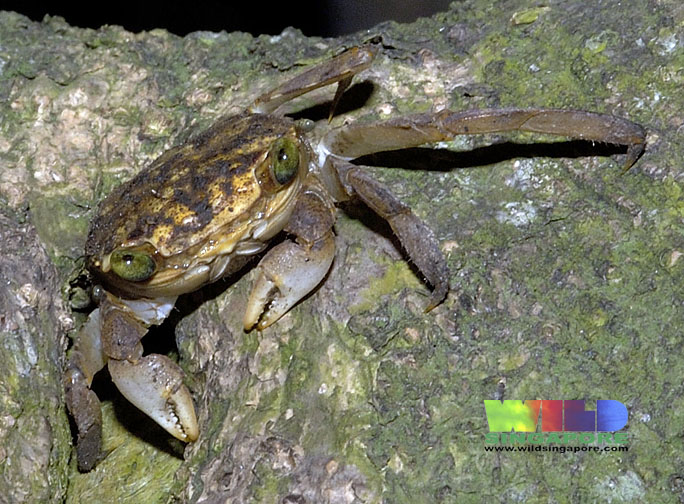 |
| (Photo: Ria Tan. Permission granted) |
Introduction
Do you find small, green, cat-like eyes staring out at you in the mangrove during the night time? These eyes actually belong to the mangrove tree-dwelling crab (Selatium brockii). It is commonly found under the barks of dead trunks or inside hollow trees in Southeast Asian mangroves(11), seldom going down to the mud, hence the common name given. This species of crab is one of the few tree-dwelling mangrove crabs on Earth, which also includes the West Atlantic species, Aratus pisonii, and East African species, Parasesarma leptosoma(14).
Biology
[Animal's life history]Habitat & Lifestyle
[Environment which the animal lives in and how it lives]S. brockii is an arboreal (“living in trees”) species that is usually found at the seaward sandbank region of mangroves(3,14).
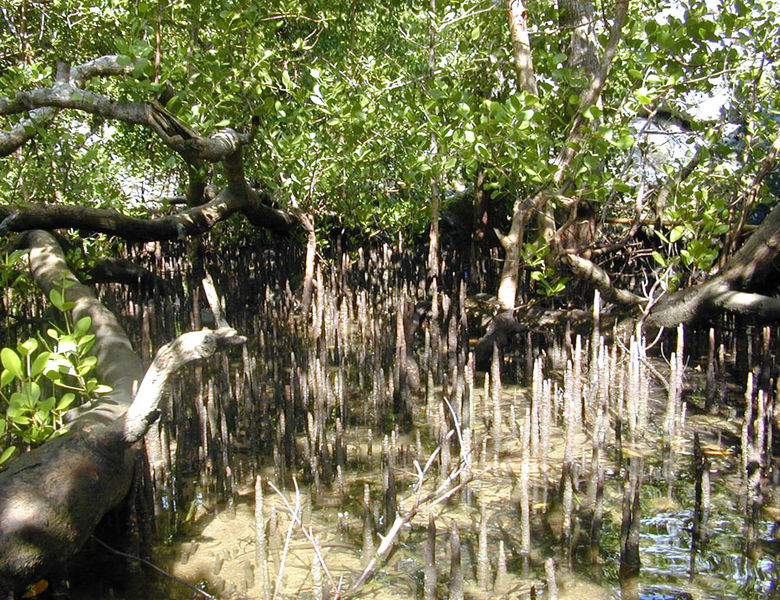 |
| Mangrove forest (Photo: Eric Guinther. Free permission) |
S. brockii are usually found in holes on tree trunks or underneath the bark of dead trees, and will come out of their hiding place during the night time to feed. It is possible that by feeding after night fall and spending most of their time in hollow trees, they reduce the chances of being eaten by hungry predators, such as fishes in the water, snakes or birds of prey. Their nocturnal activity may also be one of the methods of reducing desiccation, as there is lower temperature and higher humidity at night(5). The crabs are usually found between 1.5m to 3.0m high from the ground, probably related to the availability of epiphytic ("grows on another plant for mechanical support") algae that they feed on, which grow on lower parts of the tree trunks(9,14).
Most of the crabs that belong to the the Sesarmidae (see "Taxonomy & Phylogeny") dig burrows in the mud. As S. brockii spends most of its time on trees, it does not dig burrows(14), which is a unique characteristic that completely separates it from its other Sesarmidae relatives.
Diet and Feeding
[What and how the animal eats]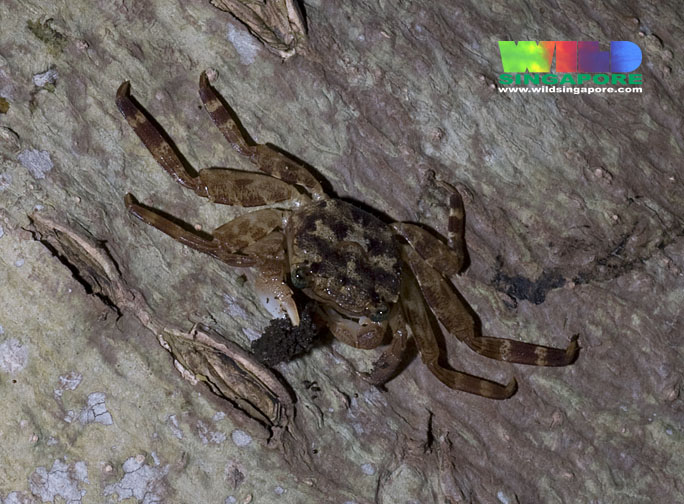 |
| S. brockii feeding on algae. (Photo: Ria Tan. Permission granted) |
The spoon-tipped structure of the chelae suggest that S. brockii is an algae feeder; but it is known to be an opportunistic omnivore, eating mangrove leaves and even insects at times(14). The sharp cutting edges of the fingers are usually used to tear off pieces of vegetation, which will be cut into smaller fragments by the mandibles ("chewing mouthparts on either side of the mouth"). The fragments will be ground into even smaller particles by the gastric mill, which is situated inside the crab body. Following this, the small particles will be broken down by commensal ("one organism benefits another") bacteria present in the gut of the crab(13).
Respiration out of water
[How the animal breathes in air]S. brockii possess gills, but they have to breathe air because of their terrestrial habits. Like all other Sesarmidae crabs, they possess reticulate ("net-like") patterns next to their mouth parts, called the "pterygostomial region" (similar to that of Perisesarma eumolpe). Water is taken up at the bases of the pereiopods through the action of setae ("short stiff hair") and flows to the gills, where gaseous exchange occurs. S. brockii will retain a "bubble" of water in their gill chamber. The "bubble" of water is then pumped out at the pterygostomial region, but will be retained and oxygenated on the large surface area of the setae that are also present on this structure(1). This structure helps to circulate and oxygenate water in the gill chamber continuously when S. brockii are out of water, enabling them to breathe atmospheric air for some time(15).
Social interaction
[How the animal interacts with other organisms]Similar to many other animals, S. brockii will fight when they are competing for limited resources, including males fighting for females as the motive principle of mating. Contest ethology of S. brockii comprises of jabs, grapples, stridulation, and lunges, in which the crab uses one or both of its chelae to attack its opponent. The most interesting fighting behaviour would be stridulation, as it involves specific morphological structures on the chelae - a row of pectinated teeth on the palm of the chelae of male crabs (circled in red), and a row of dome-shaped tubercles on the dactylus (circled in yellow). Both of the structures are present on the dorsal side of the chelae. As S. brockii is a tree-dwelling species, most of the fighting occurs atop the tree trunks.
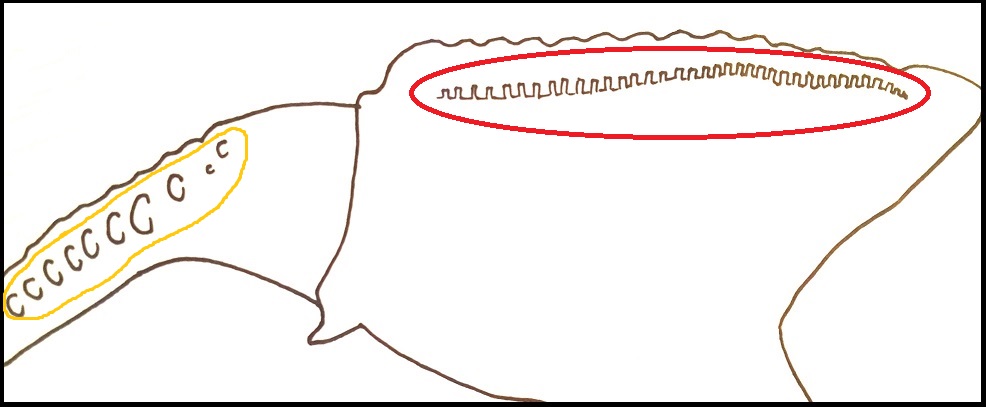 |
| Dorsal surface of the palm and dactylus of S. brockii with stridulating structures (Drawing: Lim Le Ying) |
- Jab: Rapid strike using a single chela, alternating chelae, or both chelae simultaneously. It is often used together with “grapple”.
- Grapple: Crabs interlock chelae and push against each other.
- Stridulation: The crab begins by stretching out its walking legs, twisting its body to one side, and putting one chela down on a wooden surface vertically, with the cheliped finger on the wood. It will scrap its other chela down the dorsal surface of the vertically-positioned chela until it strikes the wood, creating a knocking sound. These scraping motions are repeated around 3-17 times, and are thought to be a signal to the crab’s opponent about its strength and stamina.
- Lunge: A powerful strike characterized by a leap towards the opponent, often knocking the opponent off the tree or wood.
Larval development
[Life stages of the juvenile form] |
| Larval development of S. brockii (Original, unedited source of image: Vuayakumaranan & Kunnupandi, 1987, Figures 1-5) |
As the current results on larval development of S. brockii were conducted and observed under laboratory conditions, the exact natural environment that the larvae occupy during development and the precise time of larvae release is not known.
Distribution
[The manner in which a species is spatially arranged]S. brockii is found in mangrove forests in the Indo-Pacific region.
A list of places where this species has been found:
- Ambon, Maluku, Indonesia
- Andaman Islands
- Bohol, Central Visayas, Philippines
- Fiji
- Halmahera, North Maluku, Indonesia
- Kenya
- Northern Territory, Australia
- Parangipettai, Tamil Nadu, India
- Phuket, Thailand
- Pichavaram, India
- Pohnpei, Micronesia
- Pontianak, West Kalimantan, Indonesia
- Queensland, Australia
- Samarinda, East Kalimantan, Indonesia
- Sarawak, Malaysia
- Singapore
- Solomon Islands
- Tanzania
- Ternate, North Maluku, Indonesia
- Western New Guinea, Indonesia
Name
[Given names of the animal]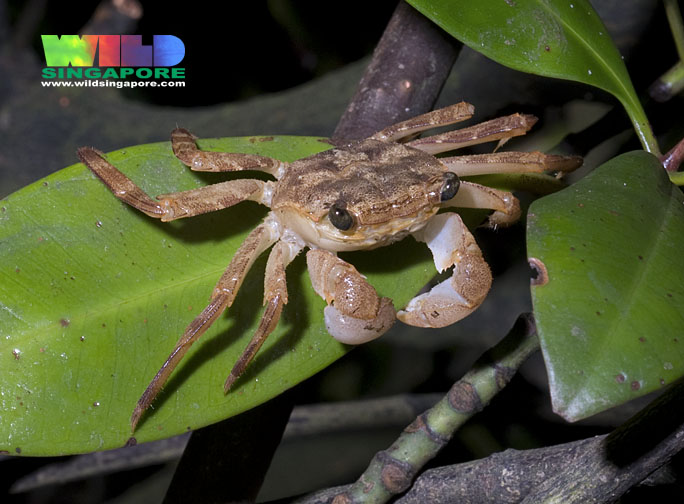 |
| S. brockii perched on a mangrove leave, showing the small size of the crab (Photo: Ria Tan. Permission granted) |
Binomial: Selatium brockii (De Man, 1887)
Synonym: Sesarma brockii
Vernacular: Mangrove tree-dwelling crab
Etymology
[Why is the animal named in this way]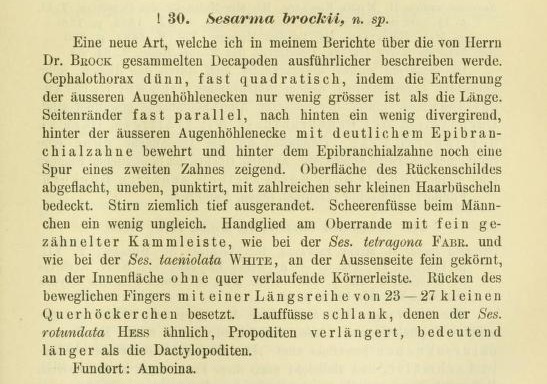 |
| Original brief description of S.brockii by De Man in 1887 |
Original statement cited from De Man’s 1887 book(6), which was written in German -“Eine neue art, welche ich in meinem Berichte über die von Herrn DR. BROCK gesammelten Decapoden ausführlicher beschreiben werde.”
Translation - “A new type, which I will describe in more detail in my reports on the information gathered from Dr. Brock’s decapods collection.”
It is possible that De Man named S. brockii after the collector of the specimen, Dr Johannes Georg Friedrich Brock.
Diagnosis
[How to differentiate this species from the rest]
S. brockii is the only species of Selatium that occurs in Singapore. It is not morphologically similar to any other species of crab in Singapore.
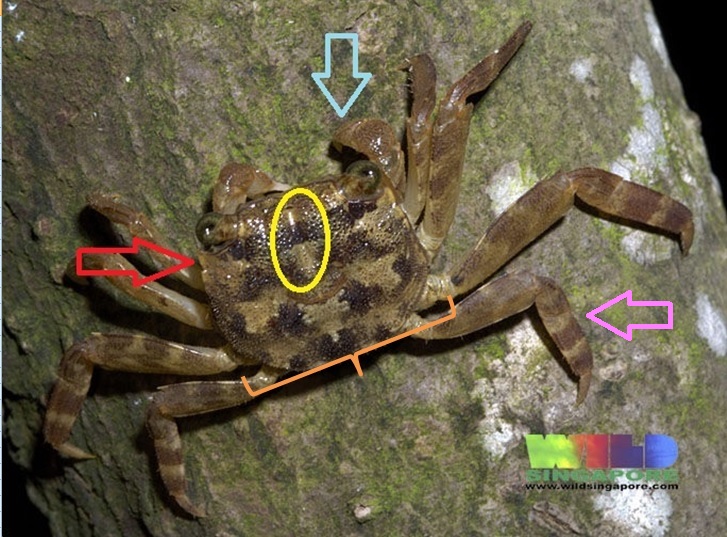 |
| Dorsal side of S. brockii. (Photo: Ria Tan. Permission granted) |
The unique morphological characteristics of S. brockii include -
1. Oblique bands present on the carapace and legs. - (pink arrow)
2. A flat, quadrate carapace, which is wider than longer. - (orange brace)
3. Deep grooves present on regions of the carapace, particularly between the eyes. - (yellow circle)
4. A distinct sharp tooth at the lateral margins of the carapace near the eyes. - (red arrow)
5. The dorsal margin of the palm of the chelae has a row of pectinated (comb-like) teeth in males, while the dorsal margin of the dactylus has a row of dome-shaped tubercles (used in stridulation). - (blue arrow)
Note: Detailed morphology of the chela can be found in the "Description" section.
The closest relative of S. brockii is S. elongatum, another mangrove crab from Selatium, and is not found in Singapore.
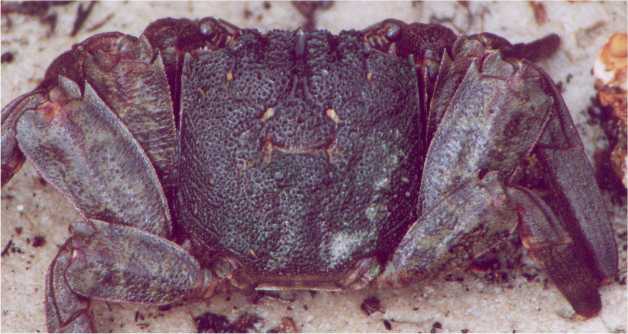 |
| Dorsal view of S. elongatum. (Permission granted from David Gillikin and Anouk Verheyden) |
Description
[Detailed description of the animal's morphology]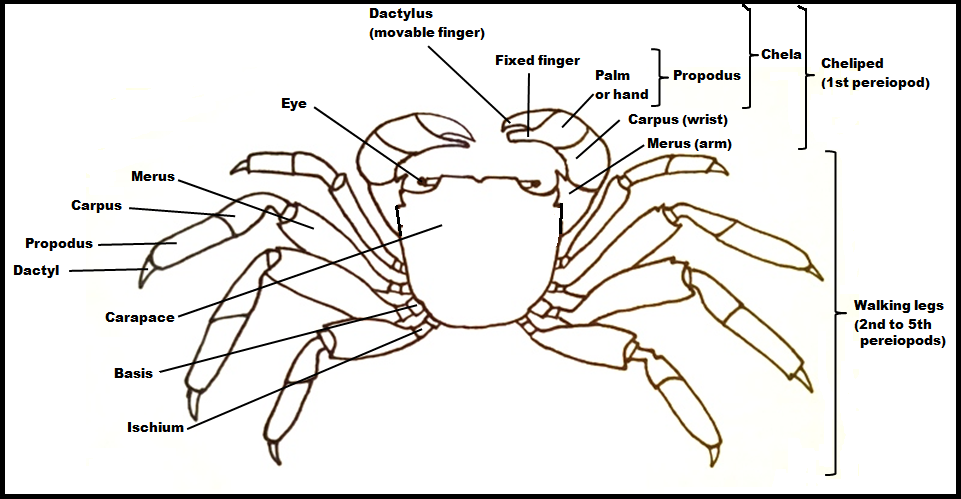 |
| Dorsal morphology of Selatium brockii. (Drawing: Lim Le Ying) |
Size
Around 2cm – 2.5cm.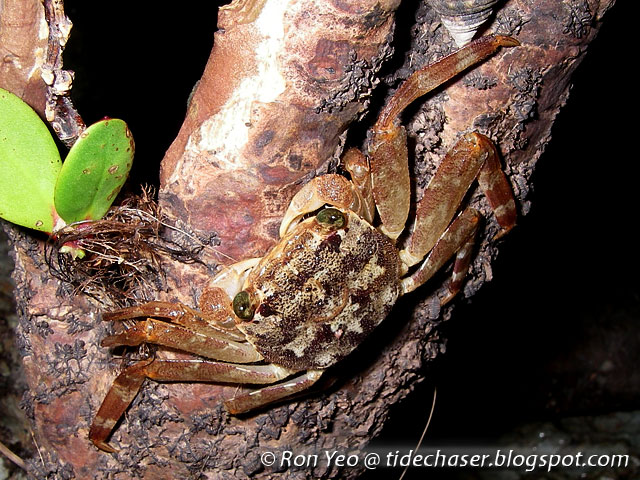 |
| (Photo: Ron Yeo. Permission granted) |
Pattern
Oblique bands present on the carapace and legs.Carapace
- Flat, quadrate, wider then longer.
- Deep grooves demarcate the different regions of the carapace.
- A distinct sharp tooth is present at the lateral margins of the carapace near the eyes.
Chelipeds
- Equal or subequal in size and shape in adult males; females have smaller chelae.
- The outer and inner surfaces of the chelae are granular.
- The tips of fingers are hoofed (spoon-like), with sharp cutting edges.
- Chelae and fingers are relatively long.
- The dorsal margin of the palm of the chelae has a row of pectinated teeth in males, which is replaced by tubercles in females.
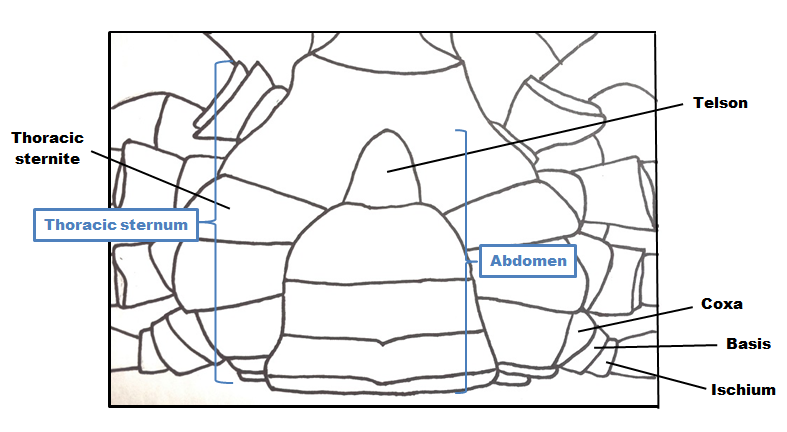
Morphology of anterior sternum and abdomen of S. brockii (Drawing: Lim Le Ying) - The dorsal margin of the dactylus has a row of dome-shaped tubercles in both sexes.
Abdomen
- Triangular shape.
- The telson is slightly longer than wide with a round tip.
Pereiopods
- Also called "ambulatory legs" or "walking legs".
- Relatively long, with the third pair of legs being the longest.
- Long propodi and short dactyli as compared to land-dwelling crabs.
[Cited from Schubart et al., 2009(11); Fratini et al., 2005(3)]
Taxonomy & Phylogeny
[Description, identification, nomenclature, and classification of organisms]Taxonomic classification
[Classification of the species according to traditional ranks]- Animalia
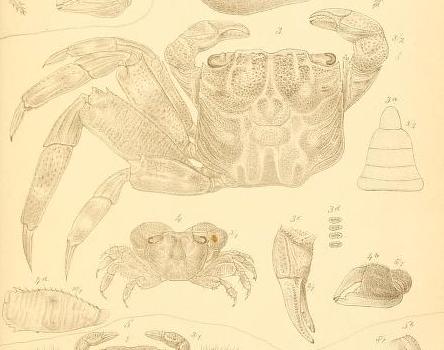
Original drawing by De Man in 1888. - Arthropoda
- Crustacea
- Malacostraca
- Decapoda
- Brachyura
- Grapsoidea
- Sesarmidae
- Selatium
- Selatium brockii (De Man, 1887)
- Selatium
- Sesarmidae
- Grapsoidea
- Brachyura
- Decapoda
- Malacostraca
- Crustacea
- Arthropoda
Taxonomic history
[Naming of the species from the past until now]Sesarma brockii - De Man, 1887; De Man, 1888; Thallwitz, 1891; Ortmann, 1894; Alcock, 1900
Sesarma (subgenus Episesarma) brockii - De Man, 1895; Nobili, 1901
Sesarma (subgenus Sesarma) brockii – Nobili, 1900; De Man, 1902; Nobili, 1903; Tweedie 1936(17)
Sesarma (Sesarma s.s.) brockii – Tesch, 1917
Sesarma (subgenus Sesarma) brockii – Serène, 1968
Neoepisesarma (subgenus Selatium) brocki - Serène & Soh 1970(12)
Sesarma (subgenus Neoepisesarma) brocki - Davie, 1982; Morgan, 1990
Selatium brocki - Hartnoll 1975; Tan & Ng 1988; Tan & Ng 1994
Selatium brockii - Sivasothi et al., 1993; Sivasothi, 2000; Fratini et al., 2005; Schubart et al., 2006; Ng et al., 2008; Schubart et al., 2009
[Cited from Tesch, 1917(16); Morgan, 1990(8); Schubart et al., 2009(11)]
Phylogenetic Tree
[Inferred evolutionary relationships among biological species based upon their physical and/or genetic characteristics]The tree below shows the phylogenetic relationship between species within Sesarmidae (the study was primarily based on East African species(10), therefore it does not comprise of all of the species within Sesarmidae ).
As shown in the tree, S. brockii and S. elongatum are monophyletic, thus supporting their grouping as the closest-related species.
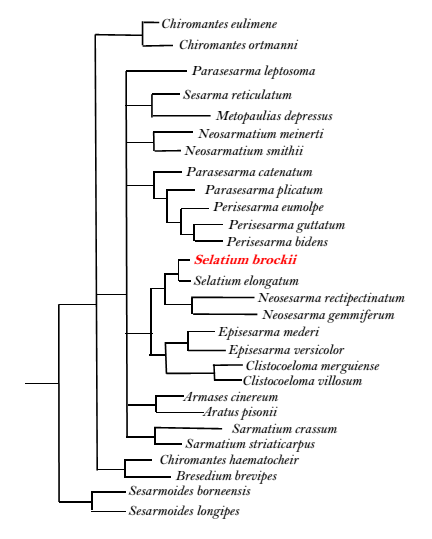 |
| Phyogenetic tree of family Sesarmidae (adapted from Schubart et al., 2006) |
Type information
[A particular specimen that serves to anchor the defining features of that particular taxon]The specimen that was examined by De Man in 1887 was collected by Dr Johannes Georg Friedrich Brock in 1885, but it cannot be located currently. It cannot be found at any of the repositories that De Man was known to have deposited his specimens, including Zoological Museum Amsterdam (collections were moved to the Naturalis Biodiversity Center, Leiden in 2011), the then Leiden Museum (now Nationaal Natuurhistorisch Museum), and Senckenberg Museum, Frankfurt am Main(2).
Note: According to De Man’s 1887(6) and 1887-1888(7) papers, the specimen was a 26mm x 23mm male S. brockii, collected from Ambon (then ‘Amboina’), Indonesia.
Links to relevant sites
BlogsThe annotated budak - Cluckings on life, nature and ducks.http://budak.blogs.com/the_annotated_budak/2012/02/selatium.html
The tide chaser. http://tidechaser.blogspot.sg/2013/07/climber-crabs-sesarmidae-singapore.html
Blogger.com. Singapore: Mandai mangroves at night -- crabs that climb trees. - http://240kids.blogspot.sg/2008/03/mandai-mangroves-at-night-crabs-that.html
Online books
A guide to seashore life in Singapore. http://mangrove.nus.edu.sg/pub/seashore/text/199.htm
Guide to the mangroves of Singapore. http://mangrove.nus.edu.sg/guidebooks/text/2050.htm
Taxonomic information and specimens
Atlas of Living Australia - sharing biodiversity knowledge. http://bie.ala.org.au/species/Selatium+brockii
National Center for Biotechnology Information (NCBI) - Taxonomy Browser. http://www.ncbi.nlm.nih.gov/Taxonomy/Browser/wwwtax.cgi
World Register of Marine Species (WORMS). http://www.marinespecies.org/aphia.php?p=taxdetails&id=444673
Personal websites
Wild Singapore – wild fact sheets. http://www.wildsingapore.com/wildfacts/crustacea/crab/sesarmidae/sesarmidae.htm
A field guide to Kenyan mangroves. Selatium elongatum. http://www.madeinnys.com/mangrove/s_elongatum.htm
Online databases
Catalogue of Life (COL). http://www.catalogueoflife.org/annual-checklist/2013/details/species/id/12813617
Encyclopedia of Life (EOL). http://eol.org/pages/2981536/overview
Raffles Bulletin of Zoology. http://rmbr.nus.edu.sg/rbz/journal.html
Comics
Purpose cartoon by Stuart Millen. http://www.stuartmcmillen.com/comics_en/purpose/#page-1
Zamora's editorial cartoon - Crab mentality. http://zamoracartoons.blogspot.sg/2011/05/crab-mentality.html
Literature and references
- Felgenhauer, B. E. & Abele, L. G. (1983). Branchial water movement in the grapsid crab Sesarma reticulatum Say. Journal of Crustacean Biology, 3(2), 187-195.
- Fransen, C.H.J.M., Holthuis, L.B. & Adema, J.P.H.M. (1997). Type-catalogue of the Decapod Crustacea in the collections of the Nationaal Naturhistorisch Museum, with appendices of pre-1900 collectors and material. Zoologische Verhandelingen, 311 (i–xvi), 1–344
- Fratini, S., Vannini, M., Cannicci, S. & Schubart, C.D. (2005). Tree-climbing mangrove crabs, a case of convergent evolution. Evolutionary Ecology Research, 7(2), 219-233
- Godsall, B. & Smallegange, I.M. (2011). Assessment Games and Competitive Behaviour of the Mangrove Tree-Dwelling Crab, Selatium brockii (De Man, 1887) (Decapoda, Grapsidae). Crustaceana, 84(14), 1697–1718
- Kyomo, J. (1986). Reproductive activities in the sesarmid crab Sesarma intermedia in the coastal and estuarine habitats of Hakata, Japan. Marine Biology, 91(3), 319-329.
- Man, J.G. De (1887). Uebersicht der Indo-pacifischen Arten der Gattung Sesarma Say nebst einer Kritik der von W. Hess und E. Nauck in den Jahren 1865 und 1880 beschriebenen Decapoden. Zoologische Jahrbücher, Abtheilung für Systematik, Geographie und Biologie der Thiere, Vol. 2, p. 651 https://archive.org/stream/cbarchive_107272_uebersichtderindopacifischenar1887/uebersichtderindopacifischenar1887#page/n13/mode/2up/search/brockii
- Man, J.G. De (1887–1888). Bericht über die von Herrn Dr. J. Brock im indischen Archipel gesammelten Decapoden und Stomatopoden. Archiv für Naturgeschichte, 53(1), 373-377, Taf XVI. http://www.biodiversitylibrary.org/item/41647#page/169/mode/thumb
- Morgan, G.J. (1990). A collection of Thalassinidea, Anomura and Brachyura (Crustacea: Decapoda) from the Kimberley region of Northwestern Australia. Zoologische Verhandelingen, 265(1), 1-90
- Ng, P. K. L., Sivasothi N, Lim, K. K. P., & Singapore Science Centre (2002). A guide to the mangroves of singapore: Animal diversity / II. Singapore: Singapore Science Centre.
- Schubart, C. D., Cannicci, S., Vannini, M., & Fratini, S. (2006). Molecular phylogeny of grapsoid crabs (decapoda, brachyura) and allies based on two mitochondrial genes and a proposal for refraining from current superfamily classification. Journal of Zoological Systematics and Evolutionary Research, 44(3), 193-199
- Schubart, C.D., Liu, H-C. & Ng, P.K.L. (2009). Revision of Selatium Serène & Soh, 1970 (Crustacea: Brachyura: Sesarmidae), with description of a new genus and two new species. Zootaxa, 2154, 1-29
- Serène, R. & Soh, C.L. (1970). New Indo-Pacific genera allied to Sesarma Say, 1877 (Brachyura, Decapoda, Crustacea). Treubia, 27(4), 387–416
- Sree, A. (2002). Proceedings of the National Conference on Utilization of Bioresources, NATCUB-2002, October 24-25, 2002, Regional Research Laboratory, Bhubaneswar. New Delhi: Allied Publ.
- Sivasothi, N. (2000). Niche Preferences of Tree-Climbing Crabs in Singapore Mangroves. Crustaceana, 73(1), 25-38
- Tan, L. W. H. & Ng, P. K. L. (2001). A guide to seashore life. Singapore: The Centre.
- Tesch, J.J. (1917) Synopsis of the genera Sesarma, Metasesarma, Sarmatium and Clistocoeloma, with a key to the determination of the Indo-Pacific species. Zoologische Mededelingen, 3, 127–260, pls. 15–17.
- Tweedie, M.W.F. (1936) On the crabs of the family Grapsidae in the collection of the Raffles Museum. Bulletin of the Raffles Museum, 12, 44–70, pls. 14, 15.
- Vuayakumaranan, G. & Kunnupandi, T. (1987). Laboratory-reared zoeae and megalopa of the mangrove crab Sesarma brockii De Man. Ind. J. Fish., 34, 133–144